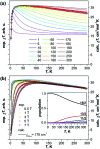Giant exchange coupling and field-induced slow relaxation of magnetization in Gd2@C79N with a single-electron Gd-Gd bond
- PMID: 29497728
- PMCID: PMC5885278
- DOI: 10.1039/c8cc00112j
Giant exchange coupling and field-induced slow relaxation of magnetization in Gd2@C79N with a single-electron Gd-Gd bond
Abstract
Magnetic properties of the azafullerene Gd2@C79N are studied by SQUID magnetometry. The effective exchange coupling constant jGd,e between the Gd spins and the spin of unpaired electron residing on the single-electron Gd-Gd bond is determined to be 170 ± 10 cm-1. Low temperature AC measurements revealed field-induced millisecond-long relaxation of magnetization.
Figures



References
-
- Sessoli R., Gatteschi D., Caneschi A., Novak M. A. Nature. 1993;365:141.
- Gatteschi D., Sessoli R., Cornia A. Chem. Commun. 2000:725.
-
- Demir S., Jeon I.-R., Long J. R., Harris T. D. Coord. Chem. Rev. 2015;289–290:149.
- Gupta T., Rajeshkumar T., Rajaraman G. Phys. Chem. Chem. Phys. 2014;16:14568. - PubMed
-
- Popov A. A., Yang S., Dunsch L. Chem. Rev. 2013;113:5989. - PubMed
Grants and funding
LinkOut - more resources
Full Text Sources
Other Literature Sources

